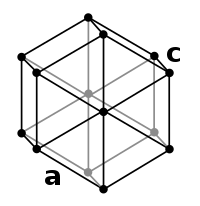
Photo from wikipedia
Recently, sodium-ion batteries have shown great potential for energy storage owing to their favorable electrochemical properties and intrinsic cost performance, which fuels the research and development of Mn-based layered oxides… Click to show full abstract
Recently, sodium-ion batteries have shown great potential for energy storage owing to their favorable electrochemical properties and intrinsic cost performance, which fuels the research and development of Mn-based layered oxides as promising sodium-ion cathodes. However, the undesirable structural evolution and oxygen redox impose great challenge on the cycling stability and rate capability of such cathodes. In this work, it is reported that Fe and Al can effectively tailor the Na2/3 Mn2/3 Fe1/6 Al1/6 O2 to trigger a stable cationic and anionic redox behavior. In situ X-ray diffraction analysis confirms the retention of a stable P2 phase upon cycling, and density functional theory results demonstrate that Al3+ doping can strengthen the covalency of MnO bond. The Na2/3 Mn2/3 Fe1/6 Al1/6 O2 cathode can retain 90% of its initial capacity within the voltage range of 2.0-4.2 V versus Na+ /Na at 200 mA g-1 after 100 cycles. Moreover, ex situ X-ray photoelectron spectroscopy reveals that the specific capacity can be replenished by the synergistic reactions between Fe3+ /Fe4+ /Fe3+ and O2- /(O2 )n - pairs within the voltage range of 4.0-4.4 V versus Na+ /Na, which is also elucidated by theoretical calculation.
Journal Title: Small
Year Published: 2022
Link to full text (if available)
Share on Social Media: Sign Up to like & get
recommendations!